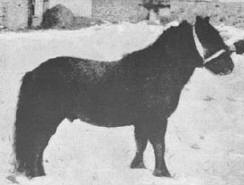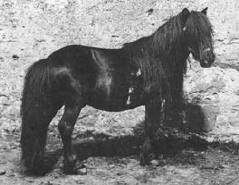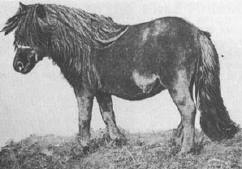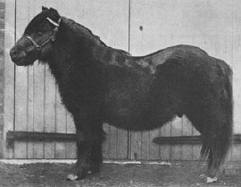|
The Stud-Book |
|
|
The first stud-book, containing details of 408 mares and 48 stallions was published in 1891. Most of these were bred on Shetland and many had several generations of pedigree. Greater numbers of ponies were registered over the next few years, partly due to the increasing demand for big black colts to work in the coal mines. Some mine owners had formed their own studs, the most important of which was that of the Marquis of Londonderry who leased two of the Shetland islands as a base for his herd. Few of these early ponies feature in today's ponies but Londonderry stock comes into every one of them. All our ponies descend from Lord Londonderry's stallion, Jack 16, who was the most influential stallion of all time. His sons and daughters occur many times in each of today's ponies. Many of the Shetland Island studs used Londonderry bred stallions. Registrations declined dramatically during and after the 2 World Wars and the Depression. However, by the mid 1960's, there was an increased interest in the breed and the number of registrations rose rapidly. The stud-book had a section, since 1910, 'Inspected Mares', for unregistered mares that were inspected and accepted for registration. Most of these ponies were from pedigreed stock but either their registration details had been lost or their breeders had ceased to register their ponies. This section of the stud-book was closed in December 1971 and now only foals from registered parents will be accepted. The effects of the war years had reached Shetland too. Many of the best ponies had been sold off the islands, leaving a high proportion of poor quality stock to produce future breeding stock. Major Maurice and Mrs. Betty Cox took it upon themselves, in conjunction with the Department of Agriculture, to reverse this trend by arranging a Stallion Scheme for the islands. This involved around 18 good quality stallions being made available to crofters in different areas of Shetland. Here the Coxes founded their famous Gletness Stud based on filly foals sired by these stallions and purchased at the Island sales. Most were chestnuts and these lines are still prominent around the world today. In order to improve the quality of the small ponies and those of colours other than black, show classes for these categories were introduced. The small ponies (34" and under) are now often referred to as 'miniatures' but they are bred from the same stock as larger or 'standard' Shetlands. Often, two large ponies will produce a small pony, or, in reverse, two small ponies may produce a large one. The breed remains popular with adults and children alike, and the number of foals registered annually will ensure that the breed has a healthy future. |
|
|
|
|
|
|
|
|
|
|





